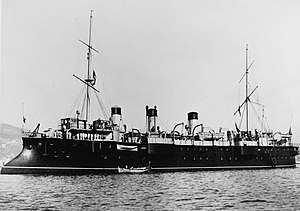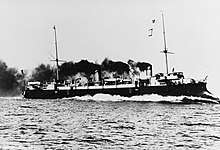D'Assas-class cruiser
The D'Assas class was a class of protected cruisers of the French Navy. The class comprised D'Assas, Cassard and Du Chayla.
 D'Assas | |
| Class overview | |
|---|---|
| Name: | D'Assas class |
| Builders: |
|
| Operators: |
|
| Preceded by: | Descartes class |
| Succeeded by: | Catinat class |
| Built: | 1894–1898 |
| In service: | 1898–1924 |
| Completed: | 3 |
| Retired: | 3 |
| General characteristics | |
| Type: | Protected cruiser |
| Displacement: | 3,962 long tons (4,026 t) |
| Length: | 96.14 m (315 ft 5 in) pp |
| Beam: | 13.67 m (44 ft 10 in) |
| Draft: | 6.25 m (20 ft 6 in) |
| Installed power: |
|
| Propulsion: |
|
| Speed: | 20 knots (37 km/h; 23 mph) |
| Complement: | 370–392 |
| Armament: |
|
| Armor: |
|
Design
In response to a war scare with Italy in the late 1880s, the French Navy embarked on a major construction program in 1890 to counter the threat of the Italian fleet and that of Italy's ally Germany. The plan called for a total of seventy cruisers for use in home waters and overseas in the French colonial empire. The D'Assas class were ordered to as part of the program, and were very similar to the earlier Friant-class cruisers.[1][2]
General characteristics and machinery

The D'Assas-class cruisers were 96.14 m (315 ft 5 in) long between perpendiculars and 99.21 m (325 ft 6 in) long overall, with a beam of 13.67 m (44 ft 10 in) and a draft of 6.25 m (20 ft 6 in). D'Assas displaced 3,962 long tons (4,026 t), while the other two vessels displaced 3,890 long tons (3,950 t). D'Assas suffered from stability problems and reportedly sat lower in the water than her sister ships.[2][3]
The ships' hulls featured a pronounced ram bow and a tumblehome shape, which were common characteristics of major French warships of the period. They had a flush deck with a sloped stern. Their superstructure consisted of a main conning tower with a bridge forward and a smaller, secondary conning tower aft. The ships were fitted with a pair of pole masts with spotting tops for observation and signaling purposes. Their crew varied over the course of their careers and ranged from 370 to 392 officers and enlisted men.[2]
The ships' propulsion system consisted of a pair of vertical triple-expansion steam engines driving two screw propellers. Steam was provided by twenty coal-burning Lagrafel d'Allest water-tube boilers that were ducted into three funnels. Their machinery was rated to produce 10,000 indicated horsepower (7,500 kW) for a top speed of 20 knots (37 km/h; 23 mph). Coal storage amounted to 600 long tons (610 t),[2] which permitted a cruising radius of 6,000 nautical miles (11,000 km; 6,900 mi) at 10 knots (19 km/h; 12 mph) and 1,000 nmi (1,900 km; 1,200 mi) at 20 knots.[4]
Armament and armor
.jpg)
The ships were armed with a main battery of six 164 mm (6.5 in) Modèle 1893 45-caliber guns. They were placed in individual pivot mounts; one was on the forecastle, two were in sponsons abreast the conning tower, and the last was on the stern. The guns fired a variety of shells, including solid cast iron projectiles, and explosive armor-piercing and semi-armor-piercing shells. The muzzle velocity ranged from 770 to 880 m/s (2,500 to 2,900 ft/s).[2][5] These were supported by a secondary battery of four 100 mm (3.9 in) Modèle 1891 guns, which were carried in pivot mounts in the conning towers, one on each side per tower.[2] The guns fired 14 kg (31 lb) cast iron and 16 kg (35 lb) AP shells with a muzzle velocity of 710 to 740 m/s (2,300 to 2,400 ft/s).[6]
For close-range defense against torpedo boats, they carried ten 47 mm (1.9 in) 3-pounder Hotchkiss guns and five 37 mm (1.5 in) 1-pounder guns. The ships were also armed with two 450 mm (17.7 in) torpedo tubes in their hull above the waterline. The torpedoes were the M1892 variant, which carried a 75 kg (165 lb) warhead and had a range of 800 m (2,600 ft) at a speed of 27.5 knots (50.9 km/h; 31.6 mph).[2][7]
Armor protection consisted of a curved armor deck that was 70 mm (2.8 in) thick on the flat portion, increasing to 80 to 100 mm (3.1 to 3.9 in) on the sides that sloped down to the side of the hull. Above the deck at the sides, a cofferdam filled with cellulose was intended to contain flooding from damage below the waterline. Below the main deck, a thin splinter deck covered the propulsion machinery spaces to protect them from shell fragments. The conning tower had 100 mm thick plating on the sides.[2]
Construction
| Name | Laid down[2] | Launched[2] | Completed[8] | Shipyard[2] |
|---|---|---|---|---|
| D'Assas | 1894 | 28 March 1896 | March 1898 | Ateliers et Chantiers de la Loire, Saint-Nazaire |
| Cassard | 1894 | 27 May 1896 | February 1898 | Arsenal de Cherbourg, Cherbourg |
| Du Chayla | March 1894 | 10 November 1895 | February 1898 | Arsenal de Cherbourg, Cherbourg |
Service history

Notes
References
| Wikimedia Commons has media related to D'Assas class cruisers. |
- "France". Notes on the Year's Naval Progress. Washington, D.C.: United States Office of Naval Intelligence. XV: 27–41. July 1896. OCLC 727366607.
- Friedman, Norman (2011). Naval Weapons of World War One: Guns, Torpedoes, Mines and ASW Weapons of All Nations; An Illustrated Directory. Annapolis: Naval Institute Press. ISBN 978-1-84832-100-7.
- Gardiner, Robert, ed. (1979). Conway's All the World's Fighting Ships 1860–1905. London: Conway Maritime Press. ISBN 978-0-85177-133-5.
- Gardiner, Robert & Gray, Randal, eds. (1985). Conway's All the World's Fighting Ships: 1906–1921. Annapolis: Naval Institute Press. ISBN 978-0-87021-907-8.
- Glennon, J. H., ed. (1894). "The Decennial Programme for Naval Construction in France". Proceedings of the United States Naval Institute. Annapolis: Naval Institute Press. XX (4): 832–838.
- Ropp, Theodore (1987). Roberts, Stephen S. (ed.). The Development of a Modern Navy: French Naval Policy, 1871–1904. Annapolis: Naval Institute Press. ISBN 978-0-87021-141-6.